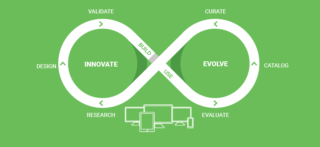Cradle to Cradle UX
The 2016 World Usability Day on November 10th is dedicated to Sustainable UX. The phrase “Sustainable UX” can be interpreted in 2 ways and this post will briefly elaborate on each interpretation and approach. The first interpretation is user experience design that aims at the heart of global sustainability, the recycling, preservation, and conservation of resources. The second interpretation is UX design and management approaches that eliminate waste of time, money, and activities that occur during innovation, ideation, design, and development. The general idea being that businesses treat experience design, process, and management as a natural resource.
The first interpretation is very much in alignment with Tim Frick’s O’Reilly publication Designing for Sustainability. In his book, Tim acknowledges the impact that UX designers have on the consumption and use of natural resources. More specifically, our global use of the internet is responsible for 830 metric tons of CO2 annually. The specific actions UX designers and developers can take to impact this footprint is through optimizing site performance, findability, usability, and green hosting. Try using the Mightybytes tool: Ecograder to see if your site is eco-friendly.

The thrust of UX for Sustainability can be taken further to apply user research, information architecture, and design in service of reducing waste, air pollution, energy production, transportation, and the consumption of natural resources related to using consumer goods. The heart of this issue is our collective human behavior. Part of the user experience field’s charter is to use design to impact human behavior by optimizing how we connect users to the information and tasks. We cognitive modeling, visual emphasis, workflow, interaction modeling and more to build behavior patterns.
Our challenge as designers is to continue to build a more holistic context for the human experience into our system design scenarios to help avoid waste and reduce consumption of resources. It may seem lofty, but information design can be used as a tool to elevate human consciousness and thereby influence our behavior to a higher state of being.
This brings me to my second interpretation of Sustainable UX. The past 20 years of software design and development has seen a widespread movement towards the evolution of highly sustainable (reusable and systemic) practices. We’ve seen the emergence of frameworks, reusable codebases and asset libraries, standardized stacks, open source contributed plugins, modules, and more. This has generated enormous time and cost savings for design and development teams, but somehow, upstream activities and artifacts have been left behind.

The vision the Limina team holds for Sustainable UX is a system that considers activities and artifacts for user researchers, business analysts, usability specialists, information architects, and UI designers into a framework for sustainable capture and reuse. This is largely an exercise in building a unified ontology for UX activities and deliverables in a relational database. Personas, Scenarios, Mental Models, Business Process, Workflows, and UI Patterns could be mapped, recalled, and reused. This way when familiar business problems arise, the relevant materials from past projects can be accessed, modified, and enhanced for the tailored deployment with less time and cost – allowing the focus on innovation, evolution, and sustainability.
We’re looking forward to a full day of Free Limina hosted UX Evaluations on November 10th as our contribution to World Usability Day! Our team will spend the entire day dedicated to evaluating and providing UX / UI enhancement and design recommendations for your site or application. Sign up for your session before they run out!
